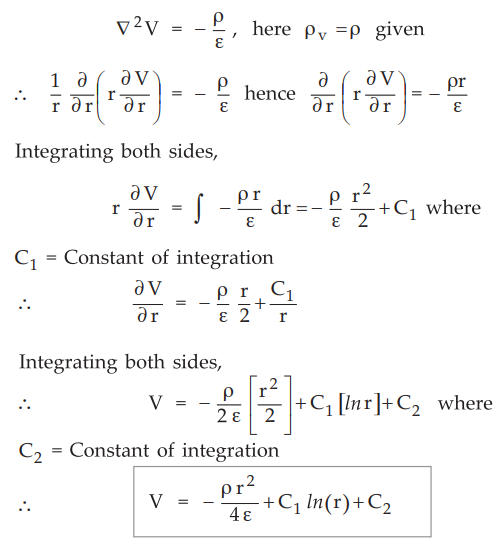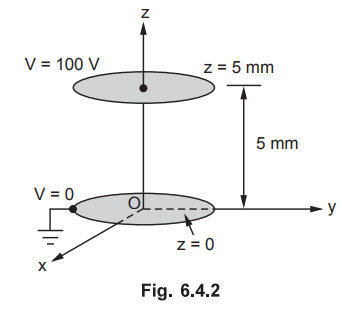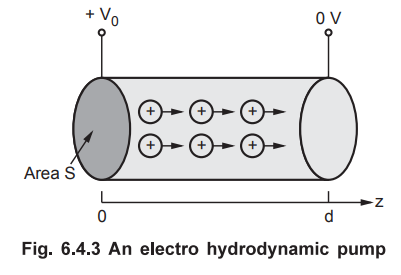Electromagnetic Theory: Unit II: (c) Poissons and Laplaces Equations
Procedure for Solving Laplace's Equation
with Example Solved Problems
• The procedure to solve a problem involving Laplace's equation can be generalized as,
Procedure for Solving Laplace's Equation
AU
: May-03,16,19, Dec.-16,18
•
The procedure to solve a problem involving Laplace's equation can be
generalized as,
Step
1 :
Solve the Laplace's equation using the method of integration. Assume constants
of integration as per the requirement.
Step
2 :
Determine the constants applying the boundary conditions given or known for the
region. The solution obtained in step 1 with constants obtained using boundary
conditions is an unique solution.
Step
3 :
Then ![]() can be obtained for the potential field V obtained, using
gradient operation
can be obtained for the potential field V obtained, using
gradient operation 
Step
4 :
For homogeneous medium,![]() can be obtained as Ɛ
can be obtained as Ɛ ![]() .
.
Step
5 :
At the surface, ρs = DN hence once ![]() is known, the normal
component DN to the surface is known. Hence the charge induced on the conductor
surface can be obtained as
is known, the normal
component DN to the surface is known. Hence the charge induced on the conductor
surface can be obtained as  .
.
Step
6 :
Once the charge induced Q is known and potential V is known then the
capacitance C of the system can be obtained.
•
If ρ v ≠ 0 then similar procedure can be adopted to solve the Poisson's
equation.
Ex.
6.4.1 The region between two concentric right circular cylinders contains a
uniform charge density p. Solve the Poisson's equation for the potential in the
region.
AU
: May-19, Marks 15
Sol.
:
The cylinders are shown in the Fig. 6.4.1.

Select
the cylindrical co-ordinate system. In co-axial cable like structure, the electric
field intensity ![]() is in radial direction from inner to outer
cylinder.
is in radial direction from inner to outer
cylinder.
Hence ![]() and V both are functions of only r and not of ϕ and z.
and V both are functions of only r and not of ϕ and z.
∂V
/ ∂r is existing while ∂ V / ∂ ϕ and ∂V / ∂z are zero,
According
to Poisson's equation,

Knowing
the boundary conditions, C1 and C2 can be obtained.
Ex.
6.4.2 Two parallel conducting discs are separated Toy distance 5 mm at z = 0
and z = 5 mm. If V = 0 at z = 0 and V = 100 V at z = 5 mm, find the charge
densities on the discs.
AU
: May-03, Marks 16
Sol.
:
The discs are shown in the Fig. 6.4.2.

Consider
cylindrical co-ordinates. The potential V is the function of z alone and is independent
of r and ϕ.

This
is the magnitude of surface charge densities on the discs. So ρs = ±177.08 nC/m2,
positive on upper plate and negative on lower plate.
Ex.
6.4.3 Find V at P (2, 1, 3) for the field of two infinite radial conducting planes
with V = 50 V at ϕ = 10° and V = 20 Vat ϕ = 30°
Sol.
: V
is a function of $ only and not the function r and z.

Ex.
6.4.4 Find V at P (2, 1, 3) for the field of two co-axial conducting cones,
with V = 50 V at θ = 30° and V = 20Vat θ = 50°.
Sol.
:
V is a function of 0 only and not the function of r and ϕ .

Ex.
6.4.5 In spherical coordinates V = - 25 V on a conductor at r = 2 cm and V =
150 V at r = 35 cm. The space between the conductor is a dielectric of Ɛr =
3.12. Find the surface charge densities on the conductor.
AU
: Dec.-16, Marks 10
Sol.
:
The voltage is a function of r only in spherical system. Hence Laplace's
equation is,

Ex.
6.4.6 In a charge free region of free space, a potential field is given as,
V(x, y) = 5x3 + f(x)-2y2 Find frx) if Ez and V
are both zero at origin.
Sol.
:
At
origin, V(0, 0) = f(0) = 0

Ex.
6.4.7 Write Laplace's equation in cartesian co-ordinates and obtain the
solution when V is function of x only for the boundary condition V = V1 at
x = x1 and V = V2 at x = x2 .
Sol.
: The
Laplace's equation in cartesian co-ordinates is,

Ex.
6.4.8 Current carrying components in high-voltage power equipment must he
cooled to carry away the heat caused by ohmic losses. A means of pumping is
based on the force transmitted to the cooling fluid by charges in an electric
field. The Electro Hydrodynamic (EHD) pumping is modelled in Fig. 6.4.3. The
region between the electrodes contains a uniform charge ρ0, which is
generated at the left electrode and collected at the right electrode. Calculate
the pressure of the pump if ρ0 = 25 mC/m3 and V0 = 22kV.

Sol
. :
Ρv = ρ0 ≠ 0 hence use Poisson’s equation,

As V is a function of z only, the equations becomes,

Hence
the required pressure for the pump is force per unit area,

Examples
for Practice
Ex.
6.4.9 Given the volume charge density ρv = -2×l07 Ɛ0√|x C/m3 in
free space, letV = 0atx = 0 and V = 2 V at x = 2.5 mm. Find V at x = 1 mm.
[Ans.
: 0.30229 V]
Ex.
6.4.10 Using Poisson's equation, obtain the
volume charge density pv inside a sphere of radius a if given field intensity
is, Er = Ar4 , for r < a and Er = Ar-2
, for r > a
[Ans.
: 6 Aer3 Cm3, 0 C/m2]
Ex.
6.4.11 In spherical co-ordinates V = 0 at r =
0.1 m and V = 100 V at r = 2 m. Assuming free space between these concentric
spherical shells, find  .
.

Ex.
6.4.12 An assembly of two concentric spherical
shells is considered. The inner spherical shell is at a distance of 0.1 m and
is at a potential of 0 volts. The outer spherical shell is at a distance of 0.2
m and at a potential of 100 V. The medium between them is a free space. Find  using spherical co-ordinate system.
using spherical co-ordinate system.

Electromagnetic Theory: Unit II: (c) Poissons and Laplaces Equations : Tag: : with Example Solved Problems - Procedure for Solving Laplace's Equation
Related Topics
Related Subjects
Electromagnetic Theory
EE3301 3rd Semester EEE Dept | 2021 Regulation | 3rd Semester EEE Dept 2021 Regulation
